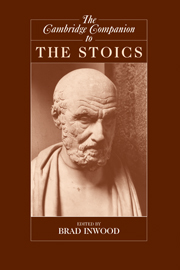Book contents
- Frontmatter
- Introduction
- 1 The School, from Zeno to Arius Didymus
- 2 The School in the Roman Imperial Period
- 3 Stoic Epistemology
- 4 Logic
- 5 Stoic Natural Philosophy (Physics and Cosmology)
- 6 Stoic Theology
- 7 Stoic Determinism
- 8 Stoic Metaphysics
- 9 Stoic Ethics
- 10 Stoic Moral Psychology
- 11 Stoicism and Medicine
- 12 The Stoic Contribution to Traditional Grammar
- 13 The Stoics and the Astronomical Sciences
- 14 Stoic Naturalism and Its Critics
- 15 Stoicism in the Philosophical Tradition
- Bibliography
- List of Primary Works
- Index
8 - Stoic Metaphysics
Published online by Cambridge University Press: 28 May 2006
- Frontmatter
- Introduction
- 1 The School, from Zeno to Arius Didymus
- 2 The School in the Roman Imperial Period
- 3 Stoic Epistemology
- 4 Logic
- 5 Stoic Natural Philosophy (Physics and Cosmology)
- 6 Stoic Theology
- 7 Stoic Determinism
- 8 Stoic Metaphysics
- 9 Stoic Ethics
- 10 Stoic Moral Psychology
- 11 Stoicism and Medicine
- 12 The Stoic Contribution to Traditional Grammar
- 13 The Stoics and the Astronomical Sciences
- 14 Stoic Naturalism and Its Critics
- 15 Stoicism in the Philosophical Tradition
- Bibliography
- List of Primary Works
- Index
Summary
INTRODUCTION
Is there a Stoic metaphysics? The answer obviously depends on what we mean by 'metaphysics', a word which no classical philosopher would have understood, despite its two Greek components and its familiarity as the title of the most famous of Aristotle's works. No matter what we might mean by 'meta-', in more than one sense the Stoics have no metaphysics: for them, no science comes 'after' physics (again, in whatever sense of 'after' you like); neither is there any science studying entities which, in some sense, are 'over and above' physics or 'beyond' physics - that is, 'metaphysical' (literally, 'super-natural') entities. For them, 'nature' (phusis) encompasses everything, including things, phenomena, and events which in other worldviews might seem to be 'super-natural' in some way. They had a firm conception of how philosophy (more exactly, its discursive exposition or logos) is and should be divided; and their primary division (into logic, ethics, physics) did not provide any place for anything like 'metaphysics'.
In another sense, however, one might suggest that the Stoics had not only one but two ‘metaphysics’. One is merely a part of physics; the other is a study over and above their standard tripartition of philosophy.
- Type
- Chapter
- Information
- The Cambridge Companion to the Stoics , pp. 206 - 232Publisher: Cambridge University PressPrint publication year: 2003
- 22
- Cited by



